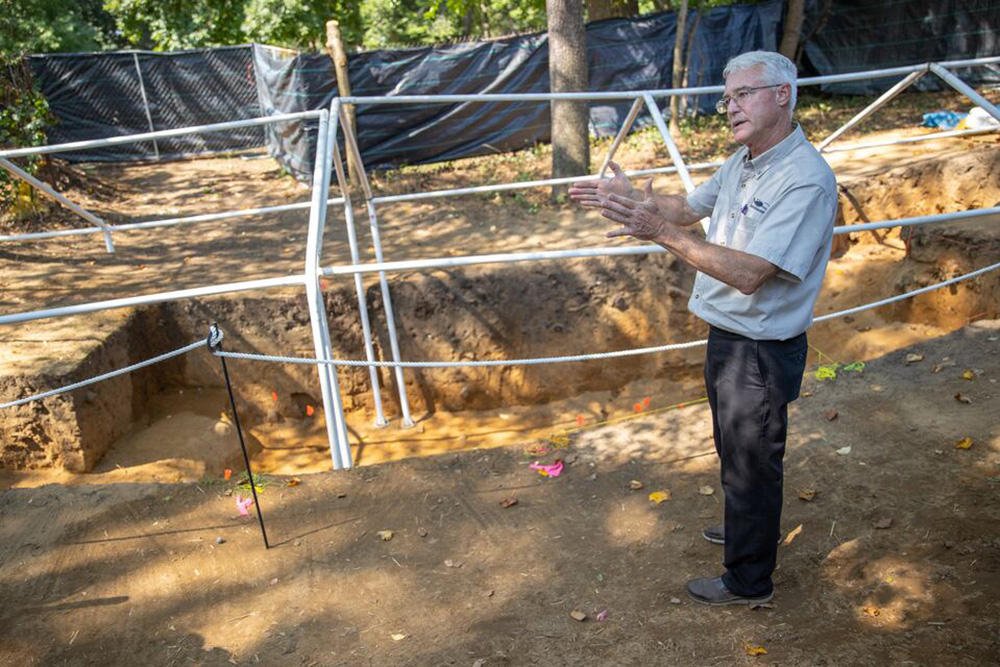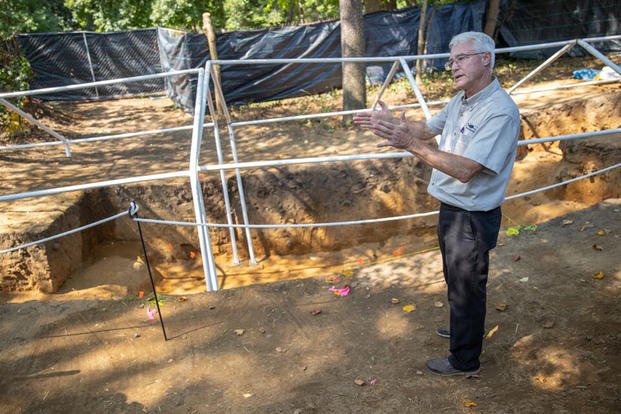

Two years after an archeological dig accidentally uncovered skeletal remains in a New Jersey field, there is now a face to help tell the story of what happened on a key Revolutionary War battlefield in 1777.
Working off of a skull recovered from a trench just outside Red Bank Battlefield Bank, a New Jersey State Police artist sketched one of the Hessian soldiers who died fighting for Great Britain against the Continental Army.
Scientists now believe 15 sets of skeletal remains, all from men, were located in the trench during the 2022 dig. DNA testing so far has failed to identify any of the soldiers, but that remains a goal of the ongoing research project, officials said Wednesday in an update on the discovery.
The newly-released image by artist Moises Martinez of the State Police’s forensic technology center includes a headdress and a mustache, both of which were associated with Hessian soldiers of that period. The rendering helps convey the humanity of those who were killed, said Jen Janofsky, director of Red Bank Battlefield Park.
“It’s not just a jumble of bones. It’s an actual human being,” Janofsky said.
Hessians were German soldiers who fought alongside King George III’s British troops and had a key role in many Revolutionary War battles.
The skull was one of only two complete crania recovered in 2022. It was found alongside teeth, bones, musket balls and other artifacts by volunteers who set out to map a wartime trench and unwittingly made a significant Revolutionary War discovery.
The skull is from a Hessian soldier who is, at least for now, known only as “No. 9,” said Wade Catts, an archeologist who led the dig at the site.
“That is, in all likelihood, what No. 9 looked like,” Catts said.
The Battle of Red Bank was a crucial victory for the Continental Army. An outnumbered group of colonists beat back an effort to capture Fort Mercer during the battle. Of the 2,000 Hessian soldiers, 377 were killed, while the victorious Continental Army only lost 14 of its 500 troops.
The conclusion that the 15 sets of remains were Hessian soldiers was based on items recovered by the remains, including a King George III gold guinea that would have been the equivalent of a soldier’s monthly pay, officials said.
Forensic scientists determined all the remains recovered from the trench were of white men of European descent. Some were middle-aged, others much younger, but the remains did not include any teenagers, officials said.
Attaining additional, more specific information has been complicated by the poor conditions of the remains, which were described as degraded from being buried in wet soil for nearly 250 years.
Janofsky said further testing may still create a breakthrough. Researchers will be conducting testing on two petrous bones, known for being the hardest bone in the human body and potentially a source of well-preserved DNA.
“Over the past two years, I’ve come to appreciate the complexity of research required to identify remains. DNA analysis and stable isotope testing hold the potential to identify our soldiers. We will exhaust all resources to try to recover the stories of these men,” Janofsky said.
The discovery of the remains was made in June 2022 on the fourth and final day of a public dig that attracted more than 100 volunteers. It prompted a surge of interest in the Battle of Red Bank and Red Bank Battlefield Park, located in National Park, a borough in Gloucester County on the Delaware River.
The battlefield is not part of the similarly-named Borough of Red Bank in Monmouth County, located about 90 miles away on the Navesink River.
Red Bank Battlefield Park covers 44 acres and is owned by Gloucester County. The Revolutionary War-era trench where the remains were located extends onto an adjoining, quarter-acre site that was acquired by Gloucester County in 2020 and had not been thoroughly explored by archeologists until the 2022 dig.
“It’s been a whirlwind two years. It’s been so exciting to see the amount of attention that the project has received and the continued excitement that people express in the project and the work that we are doing,” Janofsky said.
It is unclear where the remains will end up. Janofsky said the government of Germany was contacted following the discovery two years ago, but has not expressed an interest in retrieving them.
Volunteers, including Rowan University students, will give guided, registration-only tours of the discovery site on Aug. 10, 17 and 24, officials said.
© 2024 Advance Local Media LLC.
Visit nj.com.
Distributed by Tribune Content Agency, LLC.
© Copyright 2024 nj.com. All rights reserved. This material may not be published, broadcast, rewritten or redistributed.
